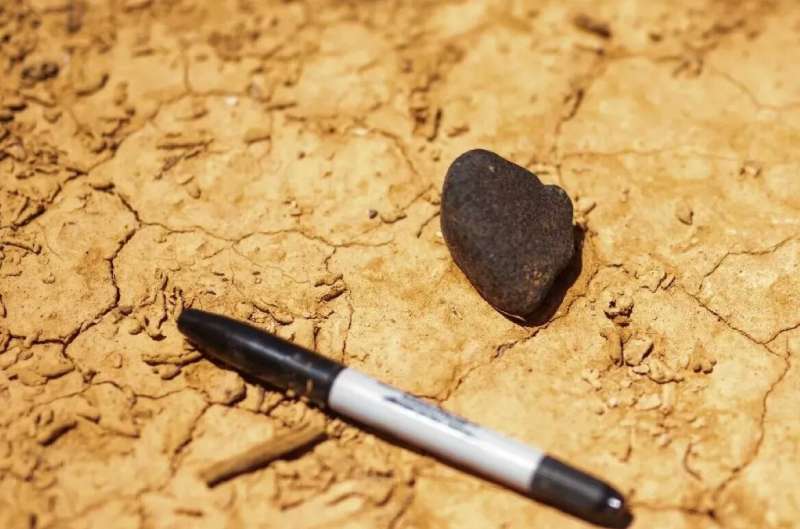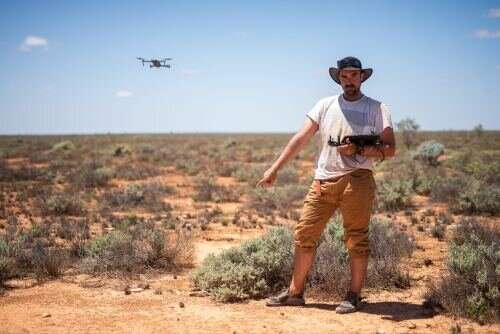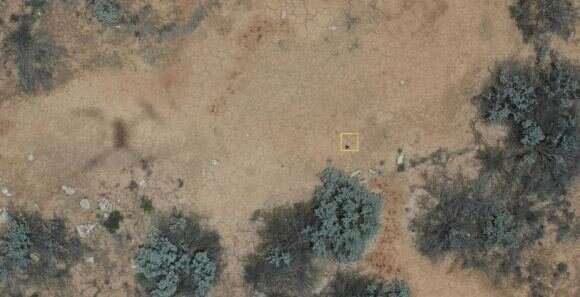
Drones have become ubiquitous in recent years. From recently discovering the Endurance to participating in wars, drones have made history in more ways than one. Now, they have a new job title to add to their resume—meteorite hunter.
A team from Curtin University in Australia came up with this new use case for a drone and recently reported on their first successful new meteorite find. Using an observational system called the Desert Fireball Network (DFN), the team tracked down and found a recent meteorite in just four days.
The first piece of the puzzle of finding the meteorite was the DFN, a series of observatories that tracks meteorites, or "shooting stars," as they are commonly called, as they enter Earth's atmosphere. Two DFN observatories, one at Mundrabilla station, and one at O'Malley siding, picked up a fireball as it entered Earth's atmosphere for 3.1 seconds on April 1, 2021. Unfortunately, the two observatories were relatively far away from the eventual landfall of the meteorite (149 km and 471 km, respectively). This distance led to some uncertainty in the exact landfall area, but they were able to limit the potential area to search to a manageable 5.1 km2.
That is still a lot of area to cover, and using a typical meteorite search technique of having groups of volunteers spread out to look for it would likely have been untenable. So the group at Curtin turned to a drone and AI algorithm to help in the process. They had developed and trained a neural network algorithm, a type of AI, to search for fallen meteorites. Using pictures of known meteorites in similar environments, they trained the algorithm on what to look for. Then they released a drone to collect images to feed into the algorithm.

That process took about three days for a DJI M300 with a mounted camera to cover the entire survey area. Luckily, the Outback of Western Australia is relatively open, making it each to spot unique rocks such as meteorites. And spot it they did. The algorithm, which breaks down images from the drone into 125 x 125 pixel tiles and then analyzes those tiles to look for potential meteorites, found the meteorite they were looking for in an image from the first day.
But that result was just one of several that passed the threshold of being interesting to look at. So after scanning the area for three days with a drone, the research team went out to find the meteorite themselves on foot. To focus their search, they concentrated on areas that the algorithm had returned an item of interest. And there, they found the 70 g meteorite pristinely in the sand. What's more, the space rock's final resting place was only 50 m from the originally suggested flight path calculated by DFN's observational network.

These results bode well for the future work of a combination of fireball tracking and drone surveillance. But, the Outback actually offers a relatively easy environment to perform such a search. Other areas, such as suburban settings or forests, could pose a challenge to this melding of modern technology. For now, though, the team from Curtin University, and meteorite hunters everywhere, can rejoice in the success of what is sure to be the first of many drone-assisted search missions.
Citation: A meteorite recently crashed into Australia, and a drone scoured the area and found it (2022, March 11) retrieved 11 March 2022 from https://phys.org/news/2022-03-meteorite-australia-drone-scoured-area.html
This document is subject to copyright. Apart from any fair dealing for the purpose of private study or research, no part may be reproduced without the written permission. The content is provided for information purposes only.
https://news.google.com/__i/rss/rd/articles/CBMiSWh0dHBzOi8vcGh5cy5vcmcvbmV3cy8yMDIyLTAzLW1ldGVvcml0ZS1hdXN0cmFsaWEtZHJvbmUtc2NvdXJlZC1hcmVhLmh0bWzSAQA?oc=5
2022-03-11 14:00:37Z
1310743680
Tidak ada komentar:
Posting Komentar